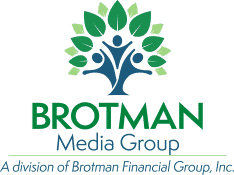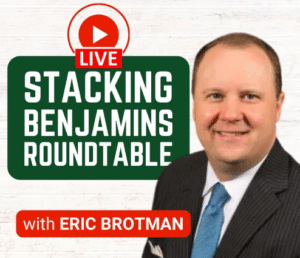There are several things to consider regarding your 401(k), including whether or not you’ve vested in the matched contributions and if you should move it somewhere else or leave it where it is.
Eric Brotman: [00:00:00] Welcome to Don’t Retire, graduate, the podcast that asks you what you want to be when you grow up so you can graduate into retirement with purpose and passion. I’m your host in valedictorian, Eric Brotman. Welcome to Office Hours where we answer listeners questions about personal finance, retirement readiness, and more.
We received a question from James who asked, what do I do with my 401K when I change jobs? And James, I love this question because there are so many different ways to answer it and so many considerations, uh, that, that you need to consider. So first and foremost, if you have been putting money into your employer’s 401k or 4 0 3 or other retirement plan, every dollar that you’ve contributed from your first paycheck of eligibility till the last one of eligibility.
Every one of those deposits is vested to you. That means that it is your money and you have some flexibility to, to move it. Now, the, the assets may have grown or may have lost [00:01:00] value based on what markets have done, uh, and how it was invested. But in terms of the dollar value of everything that you put in, is your money.
If your employer has been making contributions on your behalf via a profit sharing contribution or a 401k match or something like that, there is often a vesting schedule on the 401k that says how much of as a percentage, how much of your employer’s money? Is yours to take with you if you change jobs in, there are two different ways for this to be calculated.
Uh, and it’ll be in what’s called the summary plan description of your 401k, the S p d that will tell you if it is cliff vested or step vested. And so here’s what I mean. Cliff festing means that there’s a trigger date where it goes from 0%. It is not your money to a hundred percent, it’s all your money.
And usually that’s in years two or. . There are also ways to do step festing, which says that [00:02:00] every year a percentage and a growing percentage of that account will be yours. So it might go 0, 20, 40, 60, 80, a hundred, for example. So if you’ve been at your employer for 15 years, you’re going to be fully vested.
It’s not gonna matter if you’ve only been there for 18 months. There’s a possibility that some of your account balance will go into a forfeiture account and you will not be able to take it with you because it is not vested. So that’s the first thing you need to know is how much is vested. The next thing you need to know is, are there still dollars that your employer has to put into the plan on your behalf?
So here we are. It’s spring of 2023. If you have an employer who makes a profit sharing contribution once a year, your employer has until October 15th, 2023 to make the 2022 profit sharing contribution for you. And as long as you were employed with the company on December 31st, 2022 and eligible in that year, the company still owes you a profit sharing [00:03:00] contribution even if they haven’t made it yet.
So what that means is understanding how that works. You don’t want to take a plan and move it and then have a profit sharing, uh, contribution made to a closed plan or to, or to have to reopen it. So figure out whether the employer owes you. And if, if they do, make sure that you actually do get that. Now the next conversation is, what do I do with the money that’s vested when I change jobs?
You have a couple options. One, you can leave the money right where it is. A 401K typically cannot just bounce you from the plan. There’s some exceptions to that. Usually based on small balances. I think if you have less than $5,000 in some plans, they can send you a check essentially. Um, but assuming you have a larger balance than that, , you can leave the money exactly where it is.
Now, pros and cons to that. The pros are you don’t have to do anything. The cons are that you’re now tied to an employer plan for an employer you no longer work for. And if that employer [00:04:00] goes through reorganizations or mergers or changes plans, or any of those kinds of things, there will come a point where you have to track that down and figure out where it is currently and how it works and what your, what your rights and and responsibilities are for that.
So I normally don’t love to see money left with a prior employer. If you’ve started a new job and your new job has a 401K for which you’ll be eligible, often that 401k will allow you to roll or transfer funds from your prior employer’s plan into your new employer’s plan. So that’s an option in most cases, and you’ll find that language in the summary plan Des.
For your new employer’s plan. So that’s a relatively easy way to make sure that your money has come with you from one employer to the next, assuming you have eligibility for that plan. Now another option, rather than holding your money in your prior employer’s 401k or moving it to your new employer’s 401k, is you’re allowed to roll that money into an in an individual retirement [00:05:00] account or IRA for yourself.
There are pros and cons to this as well. The pros are it gives you unlimited flexibility in terms of how you invest the. . The cons are, it means that there may not be the same level of liability protection if you’re sued, depending on your state. Uh, and the expenses could be higher, I guess they could be lower too, but often they’re higher than they would be in the plan.
And the reason they’re higher is if you’re hiring a financial advisor like us. There will be a cost to have that money managed by a professional. So it doesn’t mean you have to do it that way. You could open an IRA with a direct vendor, a direct custodian, and potentially have it be less expensive than the 401k.
So it depends on what you’re trying to accomplish. Um, also remember that if you have traditional four oh balances and Roth 401k balances, they have to go into traditional or Roth 401ks with your new employer. Or traditional IRAs or Roth IRAs, uh, outside of your employer. So, [00:06:00] James, I know I, I, this is clear as mud.
I would tell you to talk to your cpa to talk to your financial advisor to consider all the various options. Sometimes it’s in your best interest, depending on the size of account to leave it with a prior employer or to move it to your new employer plan. Sometimes based upon your investment objectives, maybe your age or sophistication or the desire you have for certain accounts, it makes sense to roll it into an IRA for yourself.
Um, there are a lot of different, uh, variables there to consider cost being one, but not the only one. Sometimes it’s about flexibility, access, and so forth. The one thing I would implore you not to do in almost every case, is to cash in the. . I know sometimes that’s tempting because if you have a $8,000 balance and a 401k and you can just punt it and walk with a little extra cash sometimes, that’s a very compelling thing.
The thing is that if you’re under 59 and a half, not only are you paying taxes on the money, You’re paying a 10% penalty on it too. It’s a very expensive decision. [00:07:00] Uh, and you’re giving up all of the tax deferral and all of the benefits of leaving it in a 401K or IRA for the long term. So I implore you not to to punt the account unless your personal circumstances really do require it, um, and to explore all the various options available to you before you make a decision.
It’s a big decision, uh, and one not to be taken lightly. So thank you for your question. Great question. I hope I helped, uh, and we’d love to talk to you if we can help you with that. Any. If you’d like to send us a question which we might answer in a future episode of Office. Post it on our Facebook page or tweet us at brotman planning.
I’d like to thank all of you for listening and watching today. If you like what you hear, please don’t keep us a secret. Send us a message, leave us comments and reviews. Go to Don’t retire graduate.com or any of your favorite podcast platforms. Tell family and friends about us so they can share your journey to financial independence with you.
Uh, thank you again for coming to Office Hours. Be sure to tune in for new content every Thursday for. This is your host, Eric Brotman, [00:08:00] reminding you don’t retire, graduate.
Narrator: Securities offered through Kestra Investment Services, LLC. (Kestra IS) Member Finra, S I P C. Investment advisory Services offered through Kestra Advisory Services, LLC. (Kestra AS) an affiliate of Kestra IS. Kestra IS or Kestra AS are not affiliated with Brotman Financial or any other entity discussed.







